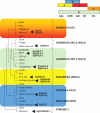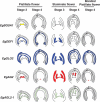Determination of flower structure in Elaeis guineensis: do palms use the same homeotic genes as other species?
- PMID: 17355996
- PMCID: PMC2735288
- DOI: 10.1093/aob/mcm027
Determination of flower structure in Elaeis guineensis: do palms use the same homeotic genes as other species?
Abstract
Aims: In this article a review is made of data recently obtained on the structural diversity and possible functions of MADS box genes in the determination of flower structure in the African oil palm (Elaeis guineensis). MADS box genes play a dominant role in the ABC model established to explain how floral organ identity is determined in model dicotyledon species such as Arabidopsis thaliana and Antirrhinum majus. In the monocotyledons, although there appears to be a broad general conservation of ABC gene functions, the model itself needs to be adapted in some cases, notably for certain species which produce flowers with sepals and petals of similar appearance. For the moment, ABC genes remain unstudied in a number of key monocot clades, so only a partial picture is available for the Liliopsida as a whole. The aim of this article is to summarize data recently obtained for the African oil palm Elaeis guineensis, a member of the family Arecaceae (Arecales), and to discuss their significance with respect to knowledge gained from other Angiosperm groups, particularly within the monocotyledons.
Scope: The essential details of reproductive development in oil palm are discussed and an overview is provided of the structural and functional characterization of MADS box genes likely to play a homeotic role in flower development in this species.
Conclusions: The structural and functional data provide evidence for a general conservation of the generic 'ABC' model in oil palm, rather than the 'modified ABC model' proposed for some other monocot species which produce homochlamydeous flowers (i.e. with morphologically similar organs in both perianth whorls), such as members of the Liliales. Our oil palm data therefore follow a similar pattern to those obtained for other Commelinid species in the orders Commelinales and Poales. The significance of these findings is discussed.
Figures





References
-
- Adam H, Jouannic S, Escoute J, Duval Y, Verdeil JL, Tregear JW. Reproductive developmental complexity in the African oil palm (Elaeis guineensis) American Journal of Botany. 2005;92:1836–1852. - PubMed
-
- Adam H, Jouannic S, Morcillo F, Richaud F, Duval Y, Tregear JW. MADS box genes in oil palm (Elaeis guineensis): patterns in the evolution of the SQUAMOSA, DEFICIENS, GLOBOSA, AGAMOUS and SEPALLATA subfamilies. Journal of Molecular Evolution. 2006;62:15–31. - PubMed
-
- Adam H, Jouannic S, Morcillo F, Orieux Y, Duval Y, Tregear JW. Functional characterization of MADS box genes involved in the determination of oil palm flower structure. Journal of Experimental Botany. 2007 in press. - PubMed
-
- Ainsworth C. Boys and girls come out to play: the molecular biology of dioecious plants. Annals of Botany. 2000;86:211–221.
Publication types
MeSH terms
Substances
LinkOut - more resources
Full Text Sources
Other Literature Sources

